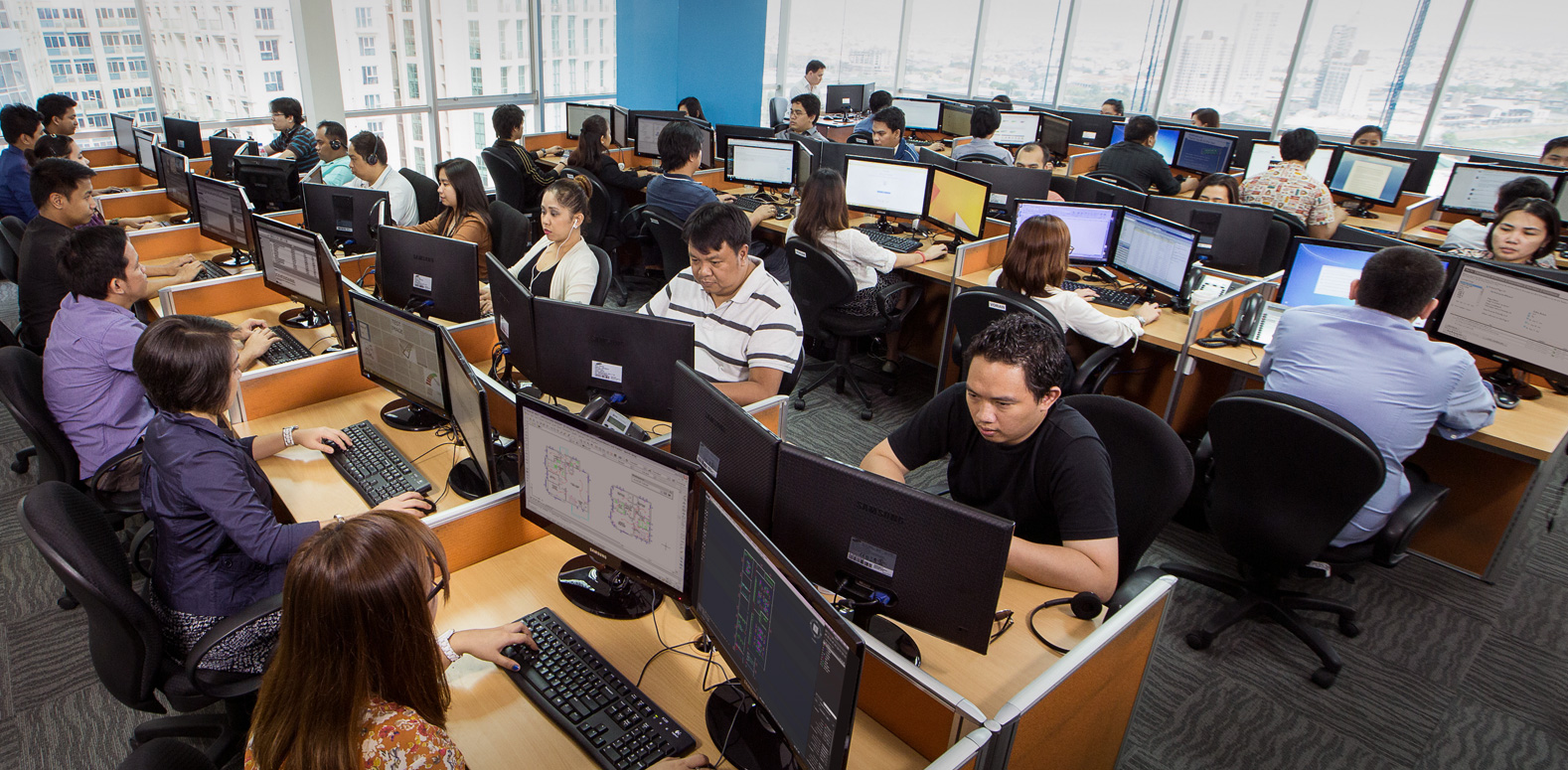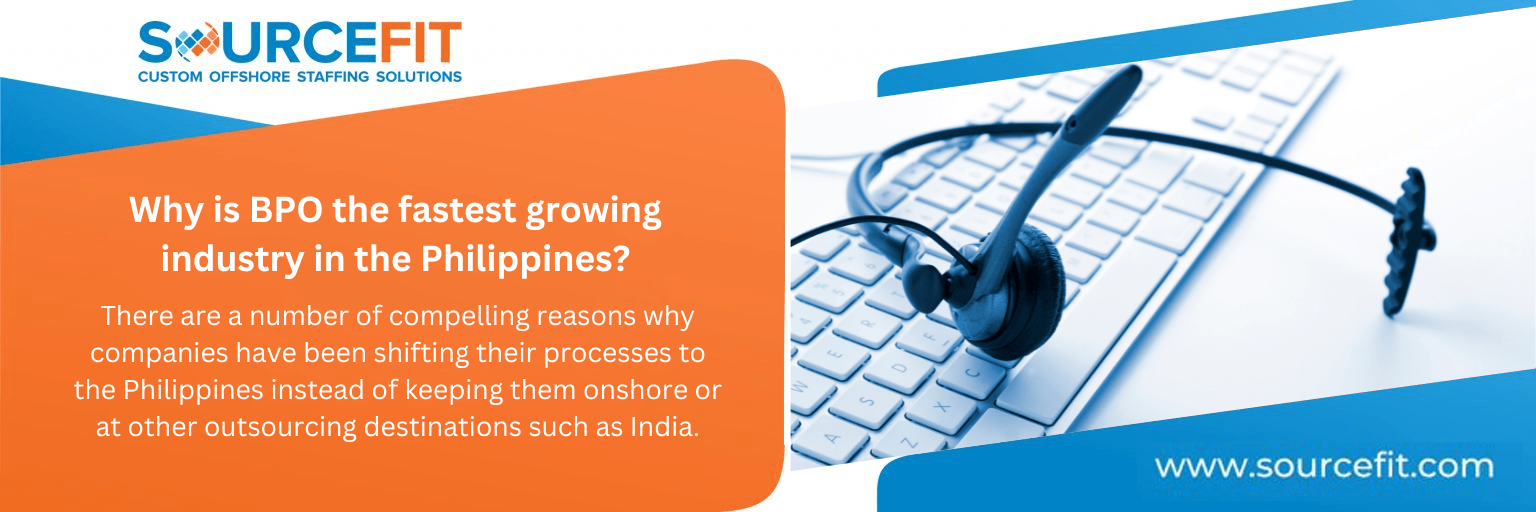BPO Philippines: Business Process Outsourcing Philippines
Business process outsourcing (BPO) remains a strong trend among organizations of all sizes. As early as 2010, a Forbes Insights Survey established that 60 % of CEOs at global enterprises believed that BPO played a very important role in supporting their business models. Today, nearly all companies outsource some part of their operations. The Oxford Business Group predicts that the global business process outsourcing industry will be worth more than $250 billion in 2023. Business process outsourcing in the Philippines accounts for 10 to 15 % of the global BPO market, where the local BPO sector has grown at a compound annual rate of 10 % over the past decade. BPO Philippines has also consistently ranked among the top five outsourcing destinations in the world.
Table of Contents:
- What is BPO?
- BPO Services
- Outsourcing Opportunities
- Why is BPO the fastest growing industry in the Philippines?
- Business Process Outsourcing in the Philippines: Challenges and Opportunities
- BPO Sector in the Philippines: Setups and Outsourcing Models
- Third Party Outsourcing
- Successful Outsourcing Projects

Datamark named the Philippines the top offshore BPO destination in 2016 due to its fast and steady growth, while Tholons placed the country within the top 10 in its 2020 TSGI (Tholons Services Globalization Index) Top 50 Digital Nations List. The index annually assesses the pace of digital transformation of industries and services around the world. These ratings are based on human capital, business environment development, costs, infrastructure, safety, digitalization and innovation.
What is Business Process Outsourcing (BPO)?
Business process outsourcing (BPO) is the contracting of a third party agency or professional to perform specific tasks and operations that are traditionally done within the organization. BPO can be local, national or offshore. Some of the non-core activities that companies outsource are back office tasks and highly specialized and technical services such as data analytics and consulting.
The BPO sector in the Philippines is the largest private employer in the country, generating about 1.43 million full-time employees (FTEs) in 2022. Its rapid and steady growth attracts many international industries to establish or expand their operations there. But where did it all start?
Business Process Outsourcing Trajectory
Manufacturing firms were the pioneers of business process outsourcing; they hired external service providers to handle significant parts of the supply chain. Global BPO later took off with the development of the internet and telecommunications. This allowed companies to easily hire someone from a country with more affordable labor.
One of the main concerns among organizations in the early days of BPO was loss of control. Many executives were worried about assigning critical tasks to people on the other side of the world. With time, outsourcing providers have addressed these concerns through innovative management and oversight strategies.
Globalization and technical innovation continue to inform how business is done around the world. The same is true for the BPO industry, service providers and BPO workers. In addition, BPO is constantly evolving. From being mainly a cost reduction tool, BPO has become a critical strategy for most businesses.
Effective BPO campaigns still drive costs down, but executives and veteran outsourcers have learned to look past the bottom line and focus on business transformation. Managers are evaluating BPO projects based on short and long-term business value, including improvements in productivity, technology, agility and customer satisfaction.
Outsourcing to the Philippines? Contact us today
BPO Philippines Services

BPO services can be categorized into back office and front office activities. The term back office originally meant the portion of the office that doesn’t interact with customers. Popular back office BPO services include finance, accounting, human resources and IT.
Back office processes are ideal for outsourcing, especially offshoring, because the work is not considered a core competency and can be done successfully from a remote location. Benefits of back office BPO include savings on labor, overhead and rent, improved productivity, and access to local talent that is either unavailable or too costly.
Front office outsourcing, on the other hand, is the subcontracting of activities that are client-facing— including contact center services. Although customer service can be considered core to the business by some organizations, it is one of the world’s top outsourced activities. For this reason, many people associate BPO with offshore call centers. India and the Philippines have led the world in outsourced voice services for decades because of low labor costs, large talent pools, and high English proficiency.
Outsourcing Opportunities

Outsourcing in the Philippines presents significant BPO opportunities.
The country used to be a predominantly agricultural economy, but has slowly shifted focus to manufacturing and services. This has led to improvements in entrepreneurial opportunities and a wider scope of job roles. As such, foreign investors see the Philippines as an attractive offshore outsourcing destination where they have access to a talent pool of young, educated, customer-oriented and English-speaking workers at a low cost.
The Philippines workforce is constantly adapting and upgrading its skills. Even if artificial intelligence threatens to replace lower-skilled jobs in the BPO sector, more medium to high-skilled jobs are expected to be created. The government has supported the BPO sector from the very start because of the industry’s major contribution to the country’s economy. Its Philippine Development Plan considers the BPO industry essential to the country’s ten high priority development areas.
Not only has the government established tax and non-tax incentives for local and foreign businesses, as well as tax holidays and exemptions, it has also streamlined the trade process. In addition, the government encourages BPO-specific curricula within universities to prepare the future outsourcing workforce. The private sector is also working to sustain the industry expansion by funding training programs focused on emerging technologies, sustainability, and inclusion and diversity.
BPO Philippines: Outsourced Voice and Non-Voice Services

BPO Philippines: The Call Center Industry
The Philippines has surpassed India as the world’s call center capital. Call centers within the country have continuously grown in terms of service quality. Their development includes a major focus on the customer experience across channels, as well as improvements on delivery, scope of work, and technology. Because of this, companies from around the world are establishing BPO operations for the first time, or expanding existing businesses in the Philippines. New investment pledges from firms in Europe and Asia Pacific are also expected to further boost BPO growth.
BPO Non-Voice Industry in the Philippines
While the voice services industry continues to bring in the most revenue, the non-voice industry is rapidly catching up. These include healthcare, back office, software development, technology, game development, animation and other knowledge-based services. According to the IBPAP, the IT-BPO industry in the Philippines has achieved a 10% annual increase for the last decade. It’s expected to keep increasing in the following years.
Why is BPO the fastest growing industry in the Philippines?
There are a number of compelling reasons why companies have been shifting their processes to the Philippines instead of keeping them onshore or at other outsourcing destinations such as India.
Compatible Cultures
Due to its historical background, the Philippines has developed strong cultural ties with the west. The country is also known for its English proficiency; 93% of the Filipino population aged 15 and over are able to speak English. These factors place the Philippines above other outsourcing destinations. Ongoing communication free of significant cultural discrepancies or language barriers impedes future misunderstandings that may determine the success of collaborative projects between your company and your outsourced staff.
Low Costs
The engine that propels the outsourcing industry in any developing country is its lower cost of doing business. Outsourcing in the Philippines is affordable not only because wages are more cost-efficient, but also because of other reduced costs, such as affordable technology and office space. You can also avoid additional costs associated with US-based employees, such as Medicare taxes and Social Security costs.
Highly-Educated, Highly-Skilled Staff
A significant number of companies were obliged to reduce their workforce in the past two years due to the devastating effect of the pandemic. The country’s job market situation is further aggravated with over 1.6 million students graduating from higher education. Outsourcing in the Philippines provides required jobs to the growing population while ensuring qualified professionals in any area at an affordable price.
Economic Growth and Stability
The Economist’s recent country briefing on the Philippines described several positive developments in the country that signal continued economic growth and stability.
BPO Philippines: Challenges and Opportunities

Outsourcing in the Philippines has been established as a stable industry, with a steady 8-10 % annual growth and nearly $30 billion dollars per year. Reasons for outsourcing in the country are numerous; however, outsourcing has challenges and opportunities that entrepreneurs should understand.
Challenges
Artificial Intelligence
Artificial Intelligence (AI) is the simulation of human intelligence by computers. Although about 1.3 million Filipinos were employed by the BPO industry in 2019, AI poses a threat to take over jobs that require simple skills, such as manual data entry. The job market is constantly evolving due to advancements in technology. Adapting to these advancements may present a challenge.
Robotic Process Automation
Robotic Process Automation (RPA) is a software robot that mimics human actions. RPA, like all innovative technology, is allowing businesses to transfer manual, repetitive and time-consuming tasks to robots while letting humans handle complex, judgment-based activities. RPA also frees up resources, lets employees gain new skills and drives employers to become more effective at running day-to-day operations.
Examples of RPAs are customer service chat bots in call centers that perform basic support tasks that agents once provided. However, humans still perform complex support tasks such as answering tickets that require a higher level of decision-making that robots are incapable of doing.
Opportunities
AI and RPA are softwares that encourage optimization. While simpler tasks and roles disappear, other opportunities become available to those with the right skills.
In addition, skills upgrade programs are currently popular across BPO sectors amid the threat of RPA and AI. That said, analysts predict that the BPO sector will accommodate new businesses wishing to invest or expand in knowledge process outsourcing (KPO) as demand for traditional voice services start to shift. These KPO firms are expected to create new roles in market research, fraud analytics, banking insurance, actuarial engineering, web development, data integration, research and development, legal processing, and medical transcript preparation.
BPO Philippines: Service Providers and Automation Strategies
BPO providers are among the first to use RPA and AI tools to improve their services and deliver even more value to their clients. They see innovation as a powerful key to success and development. For these reasons, companies are turning to BPO to develop and execute RPA strategies.
BPO service providers in the Philippines understand that they must be on top of innovation in order to stay relevant. Workers also know they must learn new skills to be employable in a global market where creativity, strategy, and innovation are increasingly the norm instead of the exception.
Luckily, the country has strong support from the government and the private sector. Some of its funding are as follows:
- Infrastructure projects
- Improvements in information and communications technology (ICT)
- BPO courses for undergraduates
- Encouragement of IT careers for students
BPO Sector in the Philippines: Setups and Outsourcing Models
The main delivery models of business process outsourcing in the Philippines are third party outsourcing, captive centers, and hybrid outsourcing.
Third Party Outsourcing
Third party outsourcing is the transfer of assets, intellectual property and/or personnel to an entity outside the organization. This is the most common delivery model associated with BPO in the Philippines. Most companies work with third-party vendors to access talent at a lower cost.
Third-party outsourcing may also be the best option for businesses that want to reduce geographic risk and attract non-core skills. Two popular third-party outsourcing models are project-based and dedicated offshore centers.
Project-Based Outsourcing

Project-based outsourcing is suitable for companies looking for short-term cost savings on one-time or test projects of low to medium complexity.
This approach is also ideal for projects with well-defined requirements. Companies may choose project-based outsourcing when demand is irregular or when they are unable to hire full-time employees to complete the project due to budget constraints.
Project-based outsourcing also allows companies to have a dedicated team working on the project without interrupting daily operations. Short-term outsourcing projects may turn into longer-term contracts and even long-lasting vendor-client partnerships.
Types of Project-based Outsourcing Contracts
Under project-based outsourcing, BPO firms in the Philippines offer different types of contracts like staff leasing/augmentation, managed services, and function-based outsourcing.
Managed services involve end-to-end oversight, management, and monitoring of certain business functions. This model is commonly used for IT, human resources, and production support.
With staff leasing/augmentation, the vendor recruits candidates based on the client’s project requirements. The client is responsible for management, while the vendor is responsible for HR and support.
Function-based outsourcing is similar to managed services, but the project scale is larger and there is no specific delivery date.
Dedicated Offshore Centers
Dedicated offshore centers were popularized in the Philippines by software development clients. The service provider establishes a team of local professionals working full-time for the client.
Clients that want a cost-effective alternative to in-house production often use a dedicated center for long-term application/software development and IT-related projects. Besides cost savings, the client improves competitiveness through lower resource requirements in the offshore location. Dedicated offshore centers also allow clients to get started on projects right away by reducing recruitment time.
Captive Centers

An offshore shared services or captive center model is an in-house delivery model where the company owns information technology and business process facilities in an offshore location.
Captive centers are considered to be subsidiaries. Establishing captive centers in an offshore location can be ideal if you want complete control of your offshore operations. This model can be more cost-effective than third-party outsourcing if you have significant offshoring needs, as you will no longer have a middle-man earning a percentage of your outsourced work.
Captives also facilitate cultural alignment between departments or offices, improve quality control, and ensure transfer of critical skills and knowledge to the parent company. Some of the earliest captives in the country reported that domain knowledge was the top reason for establishing a unit in the country. Back when the BPO industry was new, it was difficult and expensive for these firms to access expertise in niche areas and transfer skills and capabilities to the satellite office.
The Evolution of Captive Centers
Captive centers have been around since the early 1980s. They started as offices that consolidated different global or regional in-house departments like human resources and finance under one roof. Due to cost benefits, captive centers became popular with businesses. Companies in developed areas began moving jobs and services to locations like India and the Philippines. American Express, Motorola and Citigroup are just some of the large companies that were successful with the captive model.
Other businesses were not so fortunate, suffering from uncompetitive costs and underutilization of resources. That said, if your offshoring needs are small, then it wouldn’t be financially wise to set up a captive center. Instead, you’d make more profits by either partnering up with a third party or establishing a hybrid model.
Hybrid Model

A growing number of captive centers have adopted the hybrid operational model, where some processes are kept in the center while transactional services are outsourced to third party vendors. The most successful adopters of the hybrid model are captives that already have strong partnerships with third party vendors.
Successful Outsourcing Projects

Cost savings remain the top reason for sending work offshore. However, other strategic factors like talent sourcing and ability to focus on core functions are also mentioned by organizations with experience in outsourcing. How did these companies implement their outsourcing project to achieve these goals? Here are some of the best examples of successful outsourcing projects.
Offshore Outsourced IT and Customer Support
For Unilever, offshoring was the solution to a specific issue. Global operations have led to different units using multiple enterprise resource planning (ERP) systems, so the firm made the decision in 2005 to integrate these units into one ERP system. IT services not being its core business, Unilever outsourced the development of the ERP system to a third party. The result was €700 million in annual savings on operational activities.
Networking giant CISCO is another good example of offshoring done right. The company invested over $150 million to expand its technology development business in India and establish another research and development facility in the country. The Research and Development (R&D) Center was responsible for developing new technologies, providing technical support (phone and email) to customers and deploying products and solutions very quickly. Offshoring enabled the company to raise customer satisfaction and achieve profitable growth.
Some recent startups that went on to become established companies attribute their success to offshoring. Mountain View, CA-based WhatsApp only had 35 employees in 2012, but it has since become one of the world’s most popular chat apps, with 50 million downloads in just three years after its launch. As a startup with meager seed capital, WhatsApp decided to outsource development. Most of the in-house employees performed customer support and operations, while the IT engineers were offshore (some were later relocated to the U.S).
Klout, a website and mobile app using analytics to rank users based on influence, used offshore development to bring its vision to life. Klout founder, Joe Fernandez, went to Singapore and stayed there for a few months to build a custom development team and work closely with his offshore staff to build a beta version of the product. In 2014, Klout was sold to Lithium Technologies for $200 million.
Offshore Research and Development (R&D)

Many pharmaceutical companies jumped on the offshoring wagon in the early 2000s to leverage the world’s best talent. Roche, the Swiss-based drug firm, opened a research center in Shanghai and hired Chinese scientists returning from abroad. The Roche global research chief believed that U.S. academia had been run by Chinese postdocs for many years anyway.
At that time, China and India were starting to invest heavily in biotechnology, while Singapore attracted top scientists for research centers. Indian and Chinese scientists who studied and worked in the U.S. and Europe returned to their native countries to establish their own companies, which served all of the big American pharmaceutical firms.
Procter and Gamble (P&G) is another company that continues to use offshoring to its advantage. By outsourcing some R&D activities, P&G increased its innovation productivity by 60% and generated more than $10 billion in revenues from over 400 new products. Today, about 50 percent of P&G’s innovation is due to collaboration with external providers.
Offshore Banking and Finance Services
American Express (Amex) was another offshore pioneer. Back in 1994, Amex set up a financial service center in India for its back office operations. The firm also worked with service providers in the Philippines and India for customer support, application development, maintenance, technical support, and phone support services.
In 2002, American Express teamed up with IBM to manage the Amex website, manage its computer network, maintain the database, process credit card transactions, and provide IT support to company employees. Around 2000 Amex IT professionals were transferred to IBM in the process. Amex retained product development, customer relationships and new services in-house.
Besides traditional offshoring centers like India and the Philippines, nearshore locations like Canada and Mexico have been ideal for establishing subsidiaries and manufacturing hubs for U.S. companies. IBM’s Canadian subsidiary had a 10-year contract with the National Bank of Canada, with IBM Canada handling information structure maintenance, including call centers and websites.
On that same token, financial services giant Citigroup has been offshoring IT services since 1992, with most of its IT operations conducted abroad. Citi has established multiple locations in the Philippines, India and Poland over the years. Citi’s offshore development centers have longstanding partnerships with established service providers. Other banking corporations that offshore part of their IT operations are JP Morgan, Goldman Sachs, Barclays, and Bank of America.
Outsourcing Strategy

As technology and associated issues increase in complexity, the right offshore strategy is all about driving true transformation and helping organizations meet challenges. Firms that have built business models over the last two decades still need a global workforce to transform IT services from a back office service to an innovative platform.
However, the market today requires new partnerships and ways of operating. They need to asses the outsourcing method that best suits their business needs. Strategic offshoring can create relationships that enable enterprises to anticipate, prepare, and adapt to an uncertain and constantly evolving market.

RELATED PAGES
-
-
- Top Outsourced Customer Experience (CX) Companies in the Philippines and What they can Do for your Business
- The Top Outsourced Content Moderation Companies in the Philippines
- The Top Call Center Companies in the Philippines
- Outsourcing in the Philippines: Start With Great Staff and Build a Process to Last
- Business Process Outsourcing in the Philippines
- Top Outsourcing Companies in the Philippines
- Why Outsource to SEO Experts in the Philippines
- The Top Outsourced Medical Billing Companies in the Philippines
-
POPULAR POSTS
-
-
- Guide to Banking BPO, Financial Services Outsourcing
- Finance & Accounting Outsourcing (FAO): Overview and Related Outsourced Services
- Women in Outsourcing Companies
- Definitive Guide to Technical Support Outsourcing & Offshore IT Services
- 5 Keys to Improving Quality in Offshore Business Process Outsourcing
- Outsource Bookkeeping Philippines
-
Not sure where to start? Connect with us and see how Sourcefit can help you grow your business.

 STAFF LEASING
STAFF LEASING
 VIRTUAL CAPTIVES
VIRTUAL CAPTIVES
 PROJECT-BASED SOLUTIONS
PROJECT-BASED SOLUTIONS
 CREATE A PLAN
CREATE A PLAN
 HIRE AND TRAIN
HIRE AND TRAIN
 GET STARTED
GET STARTED



